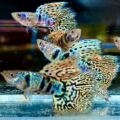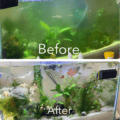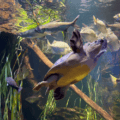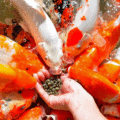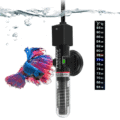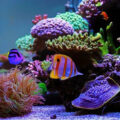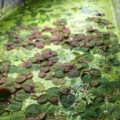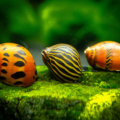Learn more about the quiet cleaning crew for your tank, the Ramshorn Snail. This is a comprehensive care guide for this algae-eating species, including practical tips for Ramshorn Snail population control, tank mates, tank setup, and overall health care.

Introduction
Most aquarium enthusiasts overlook snails as possible inhabitants of their tank, but you shouldn’t make that mistake. And other times snails become inhabitants unexpectedly as hitch-hikers.
Specific snails like the Ramshorn species or Planorbidae algae cleaner can make your tank maintenance easier. It’s a popular freshwater Mollusca known for its coiled shell but rarely appreciated for its algae-cleaning capabilities.
At the end of this freshwater snail overview, you’ll understand everything there is to know about Ramshorn Snail care and join the top percentage of aquarists who use natural cleaners for their tanks.
You’re about to dive deeper into the underwater world where there’s more than fish species to keep your interest.
See Also: The 14 Popular Freshwater Snail Species for Your Aquarium for a list of pet snail recommendations.
Quick Sidenote: Do you want to watch this article instead of reading it? Checkout the highlight video below from our YouTube Channel (Or read the more detailed article below), be sure to Subscribe For More Great Fishkeeping Content:
The Unique Look of Ramshorn Snails
When identifying Ramshorn Snails, look at their physical appearance and behaviors. Their unique appearance, however, varies based on genetics, diet, and tank conditions.
You’ll see how you can use nutrition and overall care to give your snail the best look, but first, let’s talk about its features.
Color Pattern

These colorful freshwater snails have a distinctive coiled, flat shell shaped like a ram’s horn. Depending on their diet and genetics, these Planorbidae shell patterns also have a wide range of colors, from red and brown to black and rare blue varieties.

Sometimes, their bodies have translucent tones instead of the typical dark brown or black shade.
Unique Traits
Ramshorn snails have other interesting traits that’ll stun you. They have,
- Red blood instead of blue, as compared to most other snails, which helps them survive in low-oxygen conditions.
- Adaptable strong lungs to fluctuating water conditions.
- Self-repairing shells from high-calcium diets and
- A preference for algae and biofilm diets
Creating the Perfect Tank for Ramshorn Snails
Your Ramshorn Snail tank setup should have the same essentials as any other algae-eating aquatic pet species. They need clean water, a planted environment, and ample surface area for grazing.
Here are the specifics:
Tank Layout
If you’re keeping a single Ramshorn Snail, then a 5-gallon tank is ideal. But for a larger community, you’ll need 10 to 20 gallons at least, depending on the size of their other tank mates.
This freshwater tank design also needs a layout rich in vegetation and smooth surfaces, whether rock or glass, for your snails to cling to and forage.
Water Parameters
Planorbidae aquarium habitat prefer slightly alkaline water to acidic pH levels. See the table for specific parameters.
| Temperature | 65 – 82℉ |
| pH level | 7.0 – 8.0 |
| Hardness | 8 – 18 dGH |
| Nitrate | <20 ppm |
| Nitrite & Ammonia | 0 ppm |
Decor Essentials
Live plants and driftwood are essential tank decor for Ramshorn Snails because they provide shelter and food. Use smooth substrate to prevent injury to the shells, smooth rocks for breeding, and edible plants like Hornwort, Duckweed, and Java Moss.
Ramshorn Snails: Diet for Health and Color
Because of their dietary habits, Ramshorn Snails survive on algae-based nutrition. So, you must encourage their primary role as algae grazers and scavengers with their staples and supplement their feeding for a balanced diet.
Diet Suggestions
Use these Planorbidae diet tips if you’re a first-time Ramshorn Snail keeper.
Let your pets graze on algae, biofilm, or decaying plant matter. It could be leftovers from the other aquarium tank mates if they lived in a community.
Other supplements include blanched vegetables, algae wafers, and calcium-rich fish food for shell development and repair. Some calcium sources include crushed eggshells and mineral blocks.
See Also: What Do Freshwater Aquarium Snails Eat? (+Tips) for more on feeding your freshwater snails.
Feeding Tips
Feeding Ramshorn Snails calcium-rich food helps them develop strong shells that display patterns and colors better.
Follow their natural grazing patterns by allowing algae growth on driftwood for them to eat throughout the day but feed supplemental foods only 2 – 3 times weekly. Remove uneaten food after 12 hours and decaying vegetable matter after 24 hours to keep the water clean.
Tank Mates for Ramshorn Snails: Building a Peaceful Aquarium Community
If your Ramshorn Snail will join a community aquarium, you need these Planorbidae compatibility tips.
They’re naturally peaceful and do well with non-aggressive companions but avoid predatory and snail-eating species.
Compatible Species
You can have a peaceful freshwater community if you pair your Ramshorn Snail with these species:
| Mollies | |
| Corydoras | |
| Guppies | |
| Cherry Shrimp | |
| Amano Shrimp | |
| Mystery Snails |
Avoided Species
Meanwhile, these species are NOT tank mates for Ramshorn Snails:
Snail-eaters like Loaches, predators like Pufferfish and Assassin Snails.
But choosing the perfect companions isn’t the only way to maximize your pet’s life.
Lifespan and Care Tips for Ramshorn Snails
Proper long-term Planorbidae care, like maintaining the water quality, feeding a consistently balanced diet, and keeping a stress-free environment, will help your pets live longer.
Use these tested and trusted freshwater snail health tips to keep them for 1 – 2 years.
Lifespan Factors
Focus on these factors:
- Feeding
- Tank Maintenance
- Water Quality
- Companionship
Scroll up for details on these lifespan factors.
Care Tips for Longevity
More Ramshorn Snail lifespan tips include periodic water changes and observation of the snail for behavioral or physical changes showing signs of illness.
Controlling Ramshorn Snail Population: A Balanced Approach

You will face challenges when managing the Ramshorn Snail population because they reproduce rapidly.
Note these Planorbidae reproduction tips to better understand their breeding behaviors.
- Snails are hermaphrodites (they have male and female reproductive organs).
- They lay egg clutches (clusters of eggs in hundreds)
- Their eggs multiply rapidly.
Population Management Tips
Monitoring food availability is the fastest way to control your pet’s reproduction. Reduce their food portions and the algae growth by increasing the lighting in the tank. You can also remove some egg clutches into a separate tank.
Natural Predators
Introduce natural predators like any of the species highlighted under avoided species in the section about choosing compatible tank mates.
But these practical snail population control methods help you reduce the possibility of having an overpopulated tank.
Preventing Common Health Issues in Ramshorn Snails
Ramshorn Snail health care is tricky because you can take the best precautions, but they’d still face common health issues. In this case, knowledge is power. Knowing the possible illnesses your pets could experience prepares you for preventing snail diseases.
So, let’s empower you!
Preventative Measures
Follow every instruction in this Planorbidae wellness guide, from building the ideal tank environment to preparing a nutritious algae-rich and calcium-rich diet, ensuring safe population control, and pairing your pets with compatible tank mates.
Signs of Illness
- Physical Signs: Damaged shells from calcium deficiency, acidic water, or malnutrition. The body is out of shell from stress, toxins, or infection. Translucent bodies could be a sign of malnutrition.
- Behavioral Signs: Lethargy or inactivity due to stress, aging, or infection. Floating long-term because of indigestion and trapped air. Non-movement means death or severe sickness.
First aid treatment for ill snails includes immediate quarantine, water, and dietary changes. If symptoms persist, visit an aquatic vet.
Conclusion
Now, you can agree that the Ramshorn Snail is worth adding to your community of algae-eaters. These Planorbidae aquarium tips are easy to follow for beginners and pro aquarists if you’re ready to do the work.
You have the necessary Ramshorn Snail care essentials to highlight their peaceful nature and benefit from their algae-cleaning abilities. It’s time to say goodbye to harmful chemicals and use this freshwater snail guide to introduce a new cleaning crew into your community.


